Cross stitch, Needlecraft and Embroidery Glossary: Gate stitch to Guilloche Stitch
A comprehensive illustrated needlecraft dictionary with clear definitions and working diagrams. Includes 766 terms used in cross stitch, embroidery, tapestry, blackwork, and goldwork. (Click thumbnails to enlarge.)
Work four vertical straight stitches each over six threads and then two diagonal stitches from the corners of the block and complete with a horizontal straight stitch over five threads either two threads from the top or bottom. Blocks can be worked in straight horizontal or vertical rows or dropped by half a block.
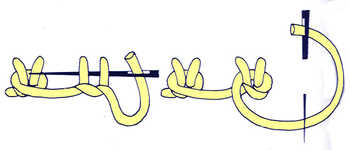
Two buttonhole stitches are worked slanted apart and the working thread is is then looped under both without entering the fabric. The thread is then pulled downwards. Also called German knotted buttonhole stitch
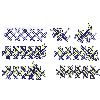
Make a band of double herringbone using only one colour. Using a tapestry needle and a contrasting colour, weave under and over the upper half of this foundation as shown in the diagram. In this first step, starting at A, the needle goes over, under, over, under, over, under and finally under both the working thread and the foundation. Continuing from B the needle goes over, under, over and under the foundation bars. Continue weaving to the end of the line, turn the corner. Starting from C the needle goes over, under, over, under both the working thread and foundation.
Then weave over the foundation bar and under both the working thread and foundation bar as shown.
Also known interlaced band.
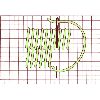
Work from left to right over five vertical and one horizontal thread. The second row is worked four threads below the first and the stitches thus formed will overlap the last thread of the previous row and make encroaching stitches.
This is a very good filling stitch for large areas and the reverse will look exactly the same as the front. Also known as interlocking gobelin stitch.
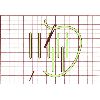
Worked left to right and then return right to left. Work upright stitches over six threads, missing two threads between. The following row is worked three threads below the first and into the missed columns. 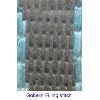
This is simple quick stitch and can be used for grading background colour.
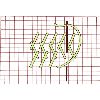
Working from top to bottom, left to right make one row of diagonal stitches over four threads vertically and two horizontally. When first row is completed work second row of diagonal stitches beginning six threads below last insertion and overlapping as shown.
Gold threads come in various weights some of which can be used for passing and some which can only be couched.
Stitches used include italian couching, burden stitch and couché rentré. Gold can also be padded with string and padded with felt. Since metallic threads are prone to unravel it is best to use a needle threader so that the end of the thread is disturbed less.
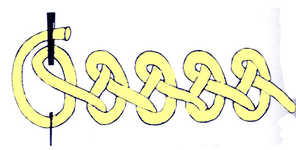
It should be worked between parallel lines and kept fairly small.
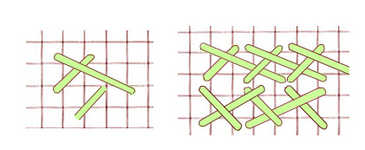
This is similar to long-armed cross stitch but only two horizontal stitches in height. It is worked in rows with the crosses alternating direction in each row. Also known as greek stitch.

This is similar to long-armed cross stitch but only two horizontal stitches in height. It is worked in rows with the crosses alternating direction in each row. Also known as Greek cross stitch.
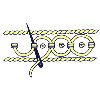
Work two rows of stem stitch up to half an inch apart. Then work small blocks of three stitches each horizontally through the centre spacing them as far apart as the distance between the rows of stem stitch. Then using a blunt (tapestry) needle slide through the blocks as shown. Leave the thread loose so that it curves. Finally work a french knot in the centre of each circle.







